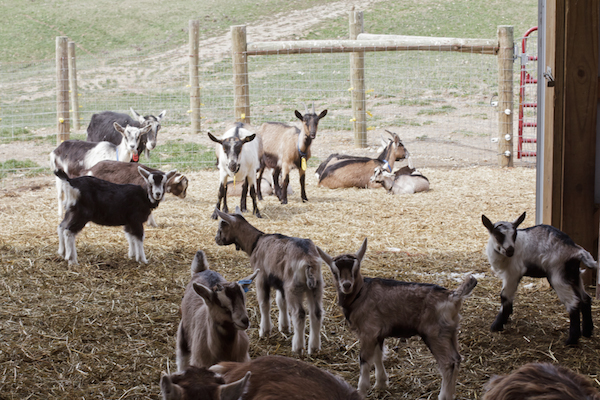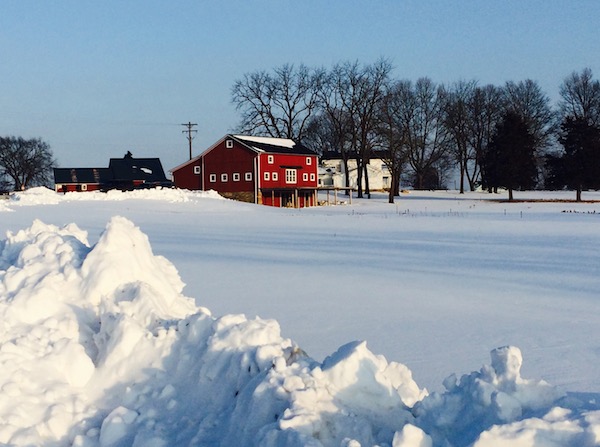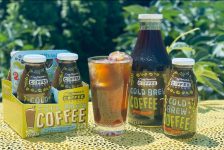Cornman Farms in Winter
“I prefer winter and fall, when you feel the bone structure of the landscape — the loneliness of it, the dead feeling of winter. Something waits beneath it, the whole story doesn’t show.”- Andrew Wyeth
To all appearances, the farm is asleep. Snow blankets the fallow fields and gently rolling pastures. It lays upon broken corn stalks, withered tomato plants, and meadows browned in the chill of autumn. The earth is frozen hard, locked tight until the warming sun of spring returns.
Yet, in the midst of this monochromatic landscape, life thrives unseen. The farm’s warm hoophouse nurtures and strengthens seedlings and sprouts in advance of early spring planting, giving them a fighting chance against the fickle and changing Michigan weather of March and April.
The farm’s animals, barn-bound since the first snows, are nurturing and growing their own young lives. This is the breeding time on the farm, and Herd Manager Kelly Young is expecting a whole new generation of goat kids, lambs, piglets, and calves come spring.
GETTING OUR GOAT(S)
There are three different goat breeds on the farm; Toggenburg, Nubian, and American Alpine. All three are known for producing high-quality milk, and the farm sells their goat milk to Zingerman’s Creamery for use in cheesemaking. The mating process begins for the goats in October, when the bucks come in to rut. During rutting (mating) season, the buck’s scent glands begin to work overtime, secreting a powerful hormonal aroma. “They smell awful,” says Kelly, laughing. “When people talk about how goats smell, what they’re talking about is the smell of the bucks in rut.” Turns out, this is the key to a lady goat’s heart. October is also is the time when the does come into heat, and they’re on the lookout for a smelly buck to help them conceive.
Goats are seasonal breeders, showing little interest by January. So, Kelly has her local veterinarian stop by in December to verify which of the does is pregnant. The vet uses a portable ultrasound device “that she wears like a purse,” according to Kelly, and the pregnant goats are marked with a paint stick to quickly identify them when birthing season approaches. The infant goats require about five months of gestation, so the does that were impregnated in October will be due in March. Kelly tells me that goats usually give birth to twins; sometimes triplets, and in rare cases, quadruplets. The goat herd is one hundred twenty-strong, with forty-seven does currently expecting.
To help her monitor the birthing process Kelly has had a camera set up in the barn, which she can check using her smartphone. Prior to the barn camera, Kelly had to actually sleep in barn so she could keep an eye on the mothers. As she puts it, “first-timers can sometimes be a challenge,” and she needs to be present to ensure the birth goes smoothly, so mom and baby are healthy and comfortable.
ANCIENT SHEEP
For the seventeen Tunis sheep on the farm, the breeding and birthing process is very similar to goats, right down to the length of the gestation period (5 months). The Tunis is a rare breed, and one of the oldest in recorded history. The distinct breed originated in Tunisia on the Northern Coast of Africa, and they were first imported into the U.S. in 1799. Thomas Jefferson supposedly owned a large herd.
While the goat herd contains several breeding bucks, the Tunis ewes have to rely on just one stud ram to help bring the new spring lambs onto the farm each year. Kelly says they call him “The General,” and he does his best to live up to his name by head-butting those who would infringe on his territory. Unlike the goats, the sheep at Cornman Farms will normally produce just one lamb per season. They’re are also much more skittish around people than the sociable goats, which can be a challenge during the monitoring and birthing process. But, the sheep are also a much hardier animal, a big plus for an overworked herd manager during birthing season.
The Tunis is known for its tender and flavorful meat, milder than most and lacking the distinct mutton taste that’s present in other breeds. This was a big part of reason why they were chosen for Cornman Farms. Tunis sheep are also renowned for their long and lustrous wool, a detail that has not escaped Kelly’s eye. “We’re going to investigate having the wool processed into yarn this year,” she says. “We’ve never done it before, so this will be a learning experience.”
Sheep shearing happens in February or March, and it’s done by a roving crew who do all of their work on a specially equipped truck. The team pull the sheep up a ramp and into the back of the truck, then use power clippers at three different stations to separate the wool from the sheep. Kelly says it’s really something to see how quickly and efficiently the shearers give the Tunis a haircut. She’s hoping that the wool will produce a significant enough amount of yarn to be able to share, and possibly sell.
THIS LITTLE PIGGY
Last year, Zingerman’s Roadhouse Chef and Cornman Farms founder, Alex Young, traveled out to Iowa to look at some pigs. It might seem like a long way to travel, but these were very special animals. Raised by Paul Willis, founder and manager of the Niman Ranch Pork Company. Niman Ranch is known far and wide for the humane care of their animals, as well as the very high quality of the resulting meat. The pigs are a Chester White/Berkshire cross-breed. The Berkshire originated in 1800’s Britain, in the county of Berkshire, and is considered a rare heritage breed, while the Chester White was originally developed in Chester County, Pennsylvania. Both breeds are prized for their delicious flavor and tender meat, as well as a higher fat content which helps it stand up to both longer cooking times and higher temperatures.
Cornman Farms currently has five breeding sows, and this past fall they borrowed a stud boar from their friends at Green Things Farm, north of Ann Arbor. The boar apparently takes his siring duties very seriously. “He got right off the truck and just started doing his job!” laughs Kelly. But the enthusiastic fellow did his job well, and Cornman Farms will likely see five litters of ten piglets each in the spring. When it comes to breeding, it seems that pigs give it their full attention right down to the smallest detail: The gestation period for these pigs is precisely three months, three weeks, and three days.
When I do the math (50 new pigs!), Kelly reminds me that Zingerman’s Roadhouse throws an entire hog on the smoker each day to keep up with the steadily rising demand for their excellent barbecue. Additionally, the Roadhouse butchers will use a lot of the meat for their own house-made sausages, ham, bacon, and pork rinds, among other things. This is a perfect example of the farm-to-table concept, where everyone, from chefs to diners, knows exactly where their food came from.
‘TIL THE COWS COME HOME
The cows at Cornman Farms have it pretty good. Kelly maintains a herd of about seven breeding cows of mixed Angus, Hereford, and Charolais breed. The Angus originated in Scotland, and is probably the most common breed of beef cattle in the U.S. Angus are also noted for the superior quality and flavor of the meat, as is the Hereford. The Charolais originated in Charolles, France, and is another prominent breed among beef cattle. Additionally, the Charolais cross-breeds well with both Hereford and Angus cattle, bringing its own high-quality traits to the resulting beef.
Cornman Farms does not have a bull. Instead, the farm rents a stud bull who, like the boar, sets to his task with the air of a professional. Which, of course, he is. Each cow will deliver one calf each spring, so the herd will periodically grow in number until the older animals have reached harvest age of two years. Cornman Farms actually keeps their cows around longer than the industry average of 14-16 months. This is a reflection of Chef Alex’s more flavorful meat for the Roadhouse. Simply put, beef that’s been allowed to more fully mature just tastes better. Alex and Kelly feed the cattle an enriched diet of organically grown alfalfa and legumes, as well as a certain percentage of grain, which contributes to the ultimate flavor of the beef. Kelly says that beef that are exclusively fed grass produce a leaner beef, but the meat also lacks some of the richness of flavor. And the reason for this is the fat. Like many chefs, Alex Young strongly feels the presence of a bit of fat contributes to keeping the meat moist and flavorful during the cooking process, and thus, better tasting. Leaner beef tends to dry out more easily during the cooking process, and the result does not make for a good steak. So the cows get to enjoy some cereal with their breakfast, and they’re happier for it.
THE PAST, PRESENT, AND FUTURE
Kelly Young has a deep connection to Cornman Farms. She is the sixth generation of her family to live on the Island Lake Road property, and her family name (Arnold) is well-represented in the history of the Village of Dexter. The field currently used for the farm’s agriculture was part of the original deed issue way back in the early 1800’s. The plot passed out of family hands for a time, and Kelly is obviously happy to have it back. There’s a sense of coming full circle. It feels like home.
This past year has been a whirlwind of experiences and learning moments. Kelly feels a sense of connection to these humble creatures that comes from raising nearly all of them from birth. Kelly grew up on a horse farm, riding, training, and showing her animals, and this experience likely gave her a leg up in understand the care of livestock. But, more importantly, Kelly thinks is an innate trait that some people simply possess. “I think there are people who know animals and can work with animals, and those who can’t. When people [or prospective farm hands] come and visit the farm, I watch how they act around the animals. You can tell who’s an animal person and who’s not.“ And Kelly, obviously, is an animal person.
When I ask Kelly what’s next for the farm, she says she’d love to bring in chickens and ducks, and possibly expand the existing herds. But, that’s down the road. Right now, her plate is pretty full with managing the herd and raising a family. “Once we have more staff, then it will be easier to manage the animals.” But that’s the future. How about right now?
“I am happier now that I’ve ever been in my entire life. I am thrilled to death that this is my job, and I can’t believe I get to do it.”






Zingerman’s Art for Sale